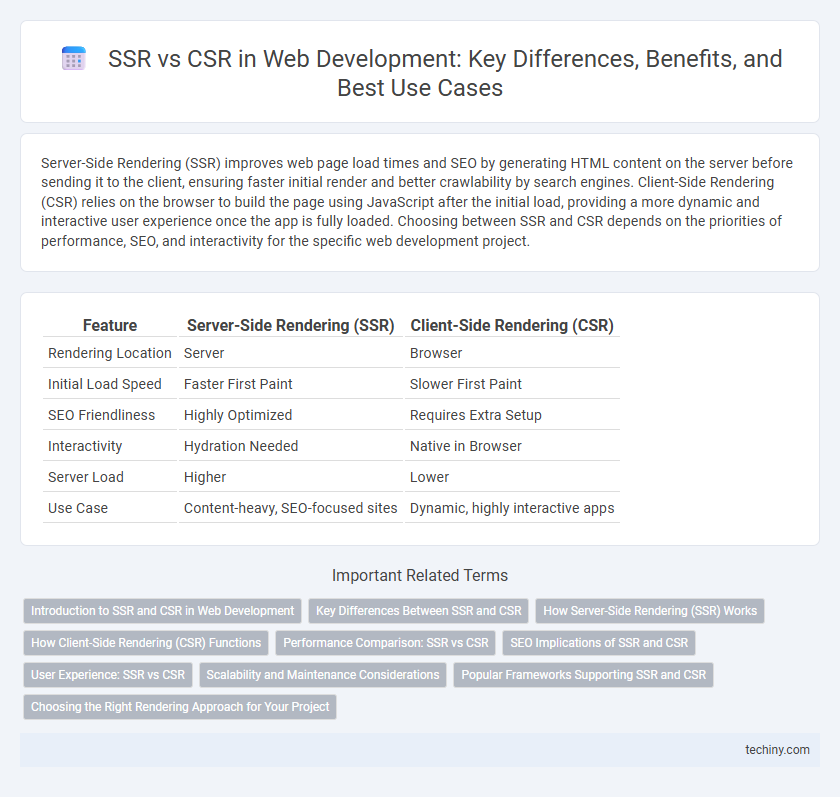Server-Side Rendering (SSR) improves web page load times and SEO by generating HTML content on the server before sending it to the client, ensuring faster initial render and better crawlability by search engines. Client-Side Rendering (CSR) relies on the browser to build the page using JavaScript after the initial load, providing a more dynamic and interactive user experience once the app is fully loaded. Choosing between SSR and CSR depends on the priorities of performance, SEO, and interactivity for the specific web development project.
Table of Comparison
| Feature | Server-Side Rendering (SSR) | Client-Side Rendering (CSR) |
|---|---|---|
| Rendering Location | Server | Browser |
| Initial Load Speed | Faster First Paint | Slower First Paint |
| SEO Friendliness | Highly Optimized | Requires Extra Setup |
| Interactivity | Hydration Needed | Native in Browser |
| Server Load | Higher | Lower |
| Use Case | Content-heavy, SEO-focused sites | Dynamic, highly interactive apps |
Introduction to SSR and CSR in Web Development
Server-Side Rendering (SSR) generates web pages on the server before sending HTML to the client, improving initial load times and SEO performance. Client-Side Rendering (CSR) relies on the browser to render content using JavaScript after the page loads, enabling dynamic interactions and smoother user experiences. Both SSR and CSR have distinct advantages in web development, with SSR enhancing performance for content-rich sites and CSR supporting highly interactive applications.
Key Differences Between SSR and CSR
Server-Side Rendering (SSR) delivers fully rendered HTML pages directly from the server, enhancing SEO and reducing initial load times, while Client-Side Rendering (CSR) relies on JavaScript to build pages in the browser, offering richer interactivity and faster subsequent navigation. SSR is ideal for content-heavy websites where search engine indexing and faster first paint are critical, whereas CSR suits dynamic single-page applications requiring seamless user interactions. The choice between SSR and CSR impacts website performance, SEO optimization, and user experience, making it essential to align rendering strategy with project goals.
How Server-Side Rendering (SSR) Works
Server-Side Rendering (SSR) generates fully rendered HTML pages on the server in response to client requests, delivering content faster to the browser by reducing initial load time. The server processes application logic, fetches data, and compiles the complete HTML document before sending it to the client, allowing immediate display without waiting for JavaScript execution. This method enhances SEO performance by providing crawlers with pre-rendered content and improves user experience, especially on slower devices or networks.
How Client-Side Rendering (CSR) Functions
Client-Side Rendering (CSR) functions by loading a minimal HTML shell from the server, then using JavaScript to dynamically generate and update the webpage content within the browser. This approach leverages frameworks like React, Vue, or Angular to manage rendering on the client, improving interactive user experiences by reducing server load and enabling faster page updates. CSR relies heavily on browser processing power and can impact initial load times due to the need to download and execute JavaScript before meaningful content appears.
Performance Comparison: SSR vs CSR
Server-Side Rendering (SSR) significantly improves initial load time by delivering fully rendered HTML from the server, enhancing SEO and user experience on slow networks. Client-Side Rendering (CSR) shifts rendering to the browser, enabling faster subsequent interactions but often results in slower first paint due to JavaScript execution. Performance metrics such as Time to First Byte (TTFB) and First Contentful Paint (FCP) typically favor SSR for initial loads, while CSR excels in dynamic content updates and rich interactivity after page load.
SEO Implications of SSR and CSR
Server-Side Rendering (SSR) improves SEO by delivering fully rendered HTML to search engine crawlers, enabling faster indexing and better visibility compared to Client-Side Rendering (CSR), which relies on JavaScript execution that some crawlers struggle to process. SSR reduces initial load time and improves performance metrics critical for SEO, such as First Contentful Paint (FCP) and Time to Interactive (TTI), enhancing user experience and search ranking. Although CSR can limit SEO effectiveness due to delayed content rendering and potential crawlability issues, modern frameworks often implement hybrid techniques like hydration to offset these drawbacks.
User Experience: SSR vs CSR
Server-Side Rendering (SSR) enhances user experience by delivering fully rendered pages quickly, reducing initial loading time and improving SEO performance. Client-Side Rendering (CSR) relies on the browser to render content dynamically, enabling smoother interactions and faster navigation after the initial load. Balancing SSR and CSR strategies can optimize performance, ensuring both fast content delivery and rich user interactivity in modern web applications.
Scalability and Maintenance Considerations
Server-Side Rendering (SSR) enhances scalability by reducing client workload and improving initial load times, making it ideal for content-rich applications with high traffic. Client-Side Rendering (CSR) offers greater flexibility and easier maintenance through component-based architectures and faster iterative updates, benefiting dynamic single-page applications. Balancing SSR and CSR depends on project complexity, team expertise, and long-term maintenance goals.
Popular Frameworks Supporting SSR and CSR
React, Next.js, and Vue.js are popular frameworks supporting both Server-Side Rendering (SSR) and Client-Side Rendering (CSR), each enhancing web application performance and SEO in distinct ways. Next.js, built on React, offers automatic SSR and static site generation for better SEO and faster load times, while React itself predominantly supports CSR with libraries to enable SSR. Vue.js supports SSR through frameworks like Nuxt.js, enabling developers to build SEO-friendly applications with efficient hydration on the client side.
Choosing the Right Rendering Approach for Your Project
Server-Side Rendering (SSR) enhances SEO and improves initial load performance by delivering pre-rendered HTML from the server, making it ideal for content-heavy or SEO-centric websites. Client-Side Rendering (CSR) offers dynamic user experiences and faster interactions after the initial load, suitable for single-page applications and complex web apps. Evaluating project requirements such as performance, SEO needs, and interactivity helps in choosing the most efficient rendering approach for optimal results.
SSR vs CSR Infographic

 techiny.com
techiny.com